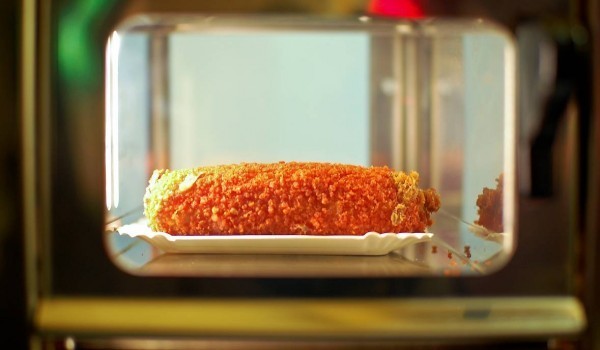
在荷蘭「snack automaat」(點心販賣機)中的荷式可樂餅。(mar.cel 攝影)
在日劇裡經常看到可樂餅(コロッケ)出現在日常生活中,它不僅是便當裡令人期待的配菜,同時也是市場裡最引人食慾的一景。因此大部分的台灣人可能都認為可樂餅是日式食物,但其實它有著純正的法國血統。這個法式點心不僅風靡了日本、也同樣席捲了鄰近的低地國。而且,荷蘭人對可樂餅的熱愛可是完全不下於日本人喔!
許多人也會好奇,可樂餅和可樂有什麼關連?其實是可樂餅的法文原名為 croquette ,是從動詞「croquer」變化而來,原意是形容咬下酥脆的食物時齒間發出的聲音。這個名字相當貼切地點出了可樂餅的特徵:麵包屑包裹著馬鈴薯泥、或是與奶油白醬混合的各式肉類、海鮮或蔬菜,再下鍋油炸成一個個小小的酥脆金黃圓餅。 1691 年,法國太陽王路易十四的御廚在自己食譜上寫下第一個可樂餅的做法,那之後沒多久,隨著法國美食與文化席捲歐洲,可樂餅就風靡了整個低地國。可樂餅也在明治時期開埠通商傳入日本,接著和漢堡排等其他西洋美食一起,發展成與「和食」相對的「洋食」,豐富了日式料理的內涵。
荷蘭文的可樂餅寫成「kroket」,正是法文 croquette 的荷式拼法。荷蘭人熱烈擁抱油炸食物的程度是眾所周知,除了炸薯條外,他們對可樂餅的鍾情程度也接近瘋狂爆表。不僅在超市可以隨意買到冷凍的、新鮮的、三合一四合一開趴專用的 Kroket ,超市買不夠,在荷蘭人發明的點心販賣機「snack automaat」裡,各式各樣的可樂餅更是必備選項,選擇之多可媲美台灣的鹽酥雞攤(驚訝請見:食尚玩家《荷蘭阿姆斯特丹的一天》);甚至連荷蘭麥當勞都有世界唯一的McKroket可樂餅漢堡在常備菜單中。此外,和台灣日本不同,這些荷式可樂餅,特別是在 automaat 裡販賣的,大部分是長條圓柱型,以方便拿取。
對勤儉的荷蘭人來說,可樂餅不僅僅是美味點心的代名詞,同時也是清冰箱的好方法。冰箱裡還有一些剩下的燉牛肉、魚片或是起司嗎?那就來作個可樂餅吧!不過荷蘭可樂餅的能耐可不只這樣,除了最經典的牛肉可樂餅(rundervleeskroket,由燉牛肉與奶油白醬製成)、與大受歡迎的爆漿起司可樂餅(kaassouffle)之外,反映地方特產與季節特性,當然也有蝦可樂餅(ganaarlkroket)和蘆筍可樂餅 (aspergekroket)。但是最令人驚奇的,是印尼炒飯與炒麵可樂餅(nasikroket & bamikroket)。酥脆的麵衣裡面包裹著貨真價實的麵與飯,初次吃到的人絕對會印象深刻(註1)。
說了這麼多,你是否也很好奇荷式可樂餅的滋味呢?荷事生非為大家介紹正宗荷式牛肉可樂餅食譜,並附上影音步驟教學。假日的時候不妨自己動手,和朋友與家人分享來自荷蘭的好滋味!
同樣來自印尼殖民背景,荷事生非也曾分享過「荷蘭千層蛋糕(spekkoek)」的故事,有興趣的讀者可以前往閱讀。
註1:印尼過去曾是荷蘭殖民地,在長達約三個半世紀的殖民時間裡,印尼料理深刻地影響了荷蘭的飲食文化,炒飯、炒麵、米粉等食物也成為荷蘭人習慣的日常食物,在超市裡和 stamppot 有著不相上下的陳列排面。炒飯與炒麵可樂餅,則是荷蘭飲食地貌另一個有趣景點。
Dutch snacks – Kroket (the Dutch croquettes)
In Taiwan, croquettes are mostly considered as “Japanese”. Yet those deep-fried little things made of mashed potatoes or stuffed with ground meat, seafood or vegetables, mixed with béchamel sauce actually have a French origin and are as common in the Netherlands. “Kroket”, the Dutch spelling of croquette clearly tells its French root. It is said that croquettes made their debut in 1691 in a recipe from the chef of King Louis XIV. The first ingredients used were truffles, sweetbread and cream cheese (how French!!). They soon made an international presence and became popular in the Low Countries in the 18th century and were introduced to Japan in the Meiji Era.
While the name “croquette” comes from the French verb “croquer”, meaning “to crunch”, it is not difficult to imagine why the Dutch, the passionate fritter-lovers, would passionately embrace them. There’s no exaggeration about the popularity of kroketten (croquettes in Dutch) in the Netherlands. Being the second most popular fast food in the Netherlands*, one can easily find those breadcrumbs-covered ragout fries everywhere. They are sold in the supermarkets in both ready-to-eat and frozen forms. Warm kroketten are the must-haves in the unique Dutch food vending machine “snack automaat”. Even McDonald’s in the Netherlands has McKroket on its menu.
Back to the history, soon as kroketten have conquered the Dutch stomachs, the frugal Dutch people found them the best way to consume leftovers. Kroketten in the Netherlands can be made in a wide range of ingredients. The most common one is “rundvleeskroket” (beef croquette), made from thickened beef ragout. They are cylinder-shaped and are enjoyed with mustard. Other kroket varieties include ganaarlkroket (shrimp croquette), aspergekroket (asparagus croquette), groentekroket (vegetable kroket) and the “bitterbal”, a popular appetizer when having a drink. As the Dutch food landscape has been strongly influenced by the Indonesian cuisine because of historical legacies**, don’t be surprised to find the Asian twist in the kroketten: there are nasi- and bami-kroket, the breaded and deep-fried fried rice and fried noodles.
Curious about how they taste? Just make yourself some of these delicious Dutch treat and see how different they are from those you used to have! Tomorrow, Oranje Express will share with you a class Dutch recipe of “rundvleekroket” with a step-by-step how-to video. So stay tuned!
Related post: DIY an McKroket (a kroketbroodje)
*The most popular fast food in the Netherlands is “frikandel”, a deep-fried sausage made of minced meat.
**Indonesia was once a Dutch colony. Immigrants and the repatriated Dutch migrants from Indonesia have made a deep cultural influence on the present-day Netherlands. Oranje Express has shared one post about the Dutch “spekkoek”, in which you can have a sneak peek into the Dutch delicacies and its culinary history intertwined with that of colonization.
https://blog.sina.com.tw/yalcinchen/article.php?pbgid=39383&entryid=602462
參考資料 References
如何自製McKroket/kroketbroodje
食尚玩家《荷蘭阿姆斯特丹的一天》
Japanese Korokke:1、2、3
Kroket on About.com
Kroket/Croquette/Krokke on Wikipedia



















很明顯的對照你文中的年代加上太陽王應該是路易十四,英文版上也是這麼寫著的,應該是筆誤吧!
真的是筆誤!剛剛已經更正,謝謝你的認真:-)